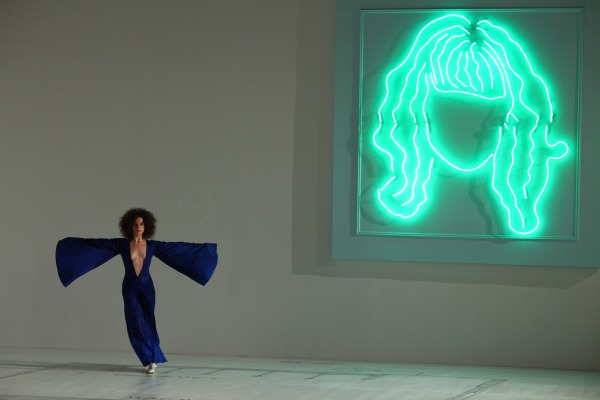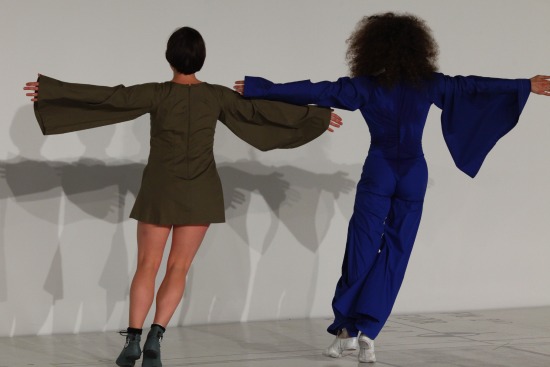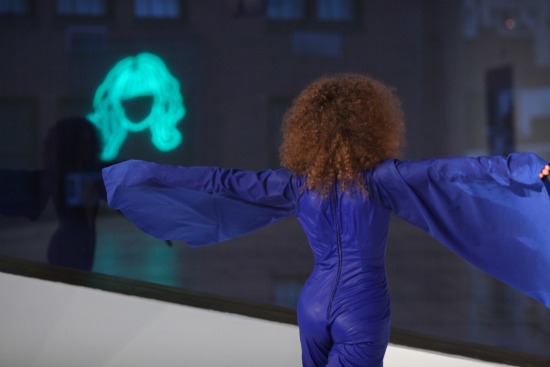The first time I saw dancing at the Whitney Museum of American Art, it was 1971 and Trisha Brown’s dancers were walking on two walls of one of the huge galleries, via ropes, pulleys, and tracks mounted on the ceilings. The last time I saw dancing at the Whitney, it was 2012 (March 1 to be exact), and Sarah Michelson’s Devotion Study #1—The American Dancer had taken over most of the museum’s fourth floor, as one of the many elements on view in the 67th edition of the Whitney Biennial. Brown skewed the viewers’ sense of gravity and altered their spatial perspective. Michelson plays with our perception of time and impetus.
Unlike many of Michelson’s brainy theatrical deconstructions, Devotion is simple in terms of its materials—the spare beauty of its design contrasting to the drama of energy expenditure on the part of its performers. The repetitive nature of the choreography reminds me slightly of Laura Dean’s early works in the 1970s, but, unlike Dean, Michelson avoids the look and escalation of ritual.
“Beauty” is a word that comes up near the end of a spoken dialogue between Michelson and Richard Maxell, who wrote the text for this (as he did for Michelson’s original Devotion at the Kitchen in 2011). As the piece starts, Michelson and curator Jay Sanders (as Maxwell) are heard talking quietly about art and what drives them to make it. The conversation (we experience it twice) sounds both natural and artificed, as if the readers were two actors seeing the words for the first time. At one point, Michelson remarks, “‘Make it very beautiful,’ she said, surprising her dancers.”
While listening to the words, we are watching dancing that becomes increasingly amazing. The gallery is entirely white or grayish white, with two banks of chairs on risers on either side of the elevators. On the wall at one end hangs a portrait outline of Michelson in green neon. The entire floor —nearly 5000 square feet in size—is covered by a surface on which has been painted the floor plan for the original Marcel Breuer building that’s now only part of the museum complex. While Michelson and Maxwell talk, Nicole Mannarino begins to dance at the left end of the long space. She’s wearing a trim, electric-blue jumpsuit with full pantlegs, kimono sleeves, and a V-shaped split from neck to waist that partially exposes her breasts (costumes by Michelson and James Kidd). White jazz shoes cover her feet, and her brown hair has been teased into a sizeable Afro.
Arms held out to either side, Mannarino begins walking backward on tiptoe, tracing counter-clockwise circles with her steps. Sometimes she seems to be traveling gradually toward the right, sometimes her steps cover more space, sometimes she pauses for a few seconds, sometimes she reverses the way she’s facing by means of a little loop. The constant ticking of a row of small speakers at the feet of the front-row spectators enforces the rhythms. For all Mannarino’s clarity and precision, she’s a mystery, and you have no idea how long she will travel these paths. Her spread arms and almost iridescent, hanging sleeves give her the semblance of wings. And when I look to my left, where a triangular, windowed promontory opens out of the room, I see her smaller reflected image flying among the neighboring buildings.
It’s worth noting that Michelson quotes George Balanchine on the luminous coolness he treasures in American dancers, a quality he terms “angelic”—by which he means, “the quality supposedly enjoyed by the angels, who, when they relate a tragic situation, do not themselves suffer.” If Mannerino is calm, Eleanor Hullihan is even more serenely strong. She enters looking like a woman warrior, with her short, khaki, kimono-sleeved tunic and low matching boots. Side by side, the two carve parallel circles over the floor, maintaining a perfect spacing in relation to each other. When they separate into separate wheels, collision becomes a dramatic possibility. As they continue imperturbably mapping out their courses, gradually expanding their orbits toward the right end of the room, James Lo’s soundscore begins to lay out its own patterns, in which low soft tones are penetrated by subtle variations in pitch and quality.
Every tiny alteration—a quick pivot, say— that the women introduce seems momentous. Also, because of the repetitive nature of the backward walking, your mind travels around. You can’t imagine how Michelson devised this piece and how the performers rehearsed it. You wonder how anyone can walk backward for so long. You watch the way sweat expands its own dark designs over the women’s costumes. You notice, when Maggie Cloud (wearing a white leotard and dark blue boots) fits herself into the ongoing parabolas, that her arms with their hyper-extended elbows look like wings, even though her sleeves are tight. Your attention is caught by the dancers’ shadows when they near the back wall: Three people, nine shadows. You imagine what curlicues they would be drawing on Breuer’s straight-lined plans if their shoes had crayons attached.
Then there’s a man too: James Tyson, bare-chested and in black pants. Then Moriah Evans in a short, oversized gray smock and gray shoes. Now there are possibilities for solo orbits set against interlocking group circles. The size of the steps and the directions may vary, but the pace never does. Tick-tick-tick go the speakers, insistent spidery voices within Lo’s altering web of sound.
The clear, white lighting by Michelson and Zach Tinkelman is augmented by the gradually intensifying glare of a suspended, upside-down bouquet of big lamps. The last performer to arrive, Kira Alker, is wearing a brown unitard and a matching horse’s head. By now Mannerino’s costume is drenched, and I can sense a tightness in her neck and shoulders. Evans exits via the open portal that has “exit” over it in neat red. While the lights brighten, the others pose in a line, extending one bent leg forward along the floor, as if to paw it. They rest there for what seems like a long time, occasionally (in unison) changing legs. The horse leaves.
A few moments before Tyson exits, something new happens. For a few seconds, the women bend over and look down as they walk, then they arch slightly to the right and lift one arm higher than the other. Suddenly beauty moves into capital letters. Mannarino looks rejuvenated.
You might think the spectators would be restless, but I don’t hear much shifting around. We’ve got something new to think about: anxiety over when the next person will exit. Devotion Study #1 has been going on for over an hour when Cloud drops out of the pattern. Shortly, just before exiting, Hullihan—oh my god!— leaps forward in a circle. As Mannarino keeps tracing her paths, Michelson’s voice begins to speak of faith, whose existence, she says, we can’t deny, even if we don’t buy religion. She tells an enigmatic story of an accident at the time of Jesus’s birth that left God with another kid—a girl named Marjorie, whom He kept by his side until the year 2K. Then He gave her the world.
Mannarino exits; she has danced for an hour and twenty minutes.
Do not seek to understand the ins and outs of the fable Michelson tells. She has given us hero angels in the form of dancers making inscrutable patterns that nevertheless have an order, a logic, and a beauty in endurance that we might well aspire to.
Devotion Study #1—The American Dancer will be performed again at the Whitney March 4, 7, 8, 10, 11 at 4PM, and March 9 at 7.




Very interesting indeed, as is the quotation from Balanchine re American dancers and angels, which I”ve seen before, but this contextualizes it very neatly. It seems to me the other attribute of American dancers, Americans in general, he admired, and indeed used, was fearlessness, also implicit in the angel-metaphor, as in “where angels fear to tread,” places like, well, the Whitney Museum.
I don’t know this choreographer; thank you for the introduction.
Deborah —
Another small correction, for the Whiteney was originall designed by Marcel (not Mark) Breuer. When you’re concentrating on catching the dance, some other things slip through the fingers. (My own spelling is impressionistic, so I know too well how such things work. But then, as an English teacher I saw words spelled in too many different ways!) So again make a silent correction.
George
I am grateful for the correction from George Dorris and from Mindy Aloff, both of whom caught the glitch that escaped me. As I type faster and faster on the hyper-sensitive keyboard of my MacBook Pro, I occasionally find that my fingers have written something I didn’t plan—something stored, obviously in some buried kinetic process of association between the various cellular intelligences I harbor. Usually I catch the error. Not this time! Post updated.
A highly visual, absorbing piece of review writing. Thank you.